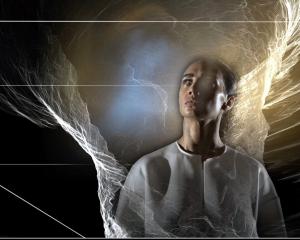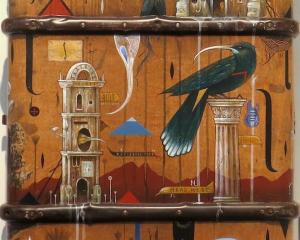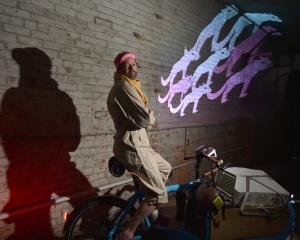Talking to Auckland artist Marie Shannon is like reminiscing with an old friend about the good times, the bad and the random, finds Rebecca Fox
Whether it is a conversation with her son, a fancy dress party gone wrong or something as seemingly normal as tidying the Christmas lights, Marie Shannon sees it differently.
All of these scenarios have led to her creating some of her favourite works, which are featured in an exhibition at the Dunedin Public Art Gallery (DPAG).
''Marie Shannon Rooms found only in the home'' features works made through her 30-year career.
Pulling together the works from her own collection and from that of the DPAG has given the artist a rare opportunity to reflect on her art.
While initially reluctant to look at the ''old stuff'', she admits it is nice to see the works together.
''It's been good to reflect. It is nice to see them in relation to each other. I've been very consistent and I work slowly. It's good to see the convergence and a nice consistent thread.''
That thread has been home and domestic life, something it took Shannon, born in 1960, time to find.
She studied art at school and continued on to Auckland's Elam School of Art.
''I was slightly horrified in fifth form [year 11] when parents stopped some of my classmates from doing art. I was perplexed; why would parents interfere. I took it for granted that I was in charge of what I did.''
She remembers as a child her mother driving her and her sister past Auckland University in her white Mini telling them that one day they could go there.
''I just followed the path of least resistance and went to art school.''
At art school, she became interested in photography but realised that what she wanted to do did not fit with the prevailing documentary-type photography of the time.
''But there was something about the medium, how it rendered things, that I liked. What I wanted to do with my work was slightly more fictional and more controlled than was popular.
''I was a misfit for a time until I discovered what I wanted to do.''
She broke away from the documentary-type work and began to do more ''contrived'' work.
''It took a while to find the thing that fitted. I seem to thrive when I'm left to my own devices.''
Art school provided that freedom as well as some valuable guidance.
Shannon soon realised commercial photography was not the right fit for her.
''I'm not very good at taking direction. I didn't have the skill to interpret what someone else wanted. My skills were far more speculative.''
So towards the end of art school she began working at a custom printing laboratory, creating hand-printed works for people in an environment supporting fine art school graduates.
She then joined a business co-operative making custom black-and-white printing. The bonus was that she had access to a professional darkroom in which she could create her own works.
''I became a very good custom printer. It was a very easy path to what became self-employment, although I didn't realise then the responsibility that would bring.''
She moved into tertiary teaching for a while, but always came back to her own work using large format camera technology.
''I do have a good digital camera, I don't use it for exhibition work, but it's good for documenting things.''
The large format 4x5 camera allows her to retain the sharpness and clarity of an image without having a grainy finish. She still uses film but scans the negatives so they can be digitally printed.
Her more recent video work is put together by computer programs.
''The fantastic thing about it is that it is fantastically portable ... although time-consuming.''
Shannon's home often provides the backdrop for what she wants to photograph.
''I've always been quite comfortable on the floor. The domestic interior is very important. I wasn't trying to talk about big important subjects, I was trying to make things very low-key, very undramatic.''
For example, one of her favourite images is Lights 2016, a photograph of Christmas lights wound around a home-made cardboard caddy sitting on brown paper.
''It's so typical of what I do. I notice something or I find something that is a real thing. This is a Christmas light caddy my partner Julian [Dashper] carefully made.''
Every Christmas they got out the lights and, still on the caddy, plugged them in to see if they worked.
''It is this very subdued celebration, I guess. I saw the aesthetic possibilities of that. They [the lights] are cheerful and extravagant when they are on the Christmas tree, but in the photo they are presented in a very downplayed, slightly melancholy way.''
Photographing the lights on brown paper emphasised that normality.
''So, for me, that is very typical, emblematic of what I do, that low-key way of highlighting ordinary things.''
Like photographing herself in 1985 wearing a rat's mask and tail, sitting in a chair in her living room with two bottles of beer on the floor beside her.
It was a costume she had made for a fancy dress party. When she turned up at the party she found she was the only one in costume. Some guests had not realised it was fancy dress, while the others had simply chosen to ignore the directive.
''I had been waiting for a friend to pick me up when I had the idea. So the next day I re-created it.
''It was something real that happened. It's not surreal. It's something I've highlighted in a domestic situation.''
Nowadays, video and writing or using text is at the core of what she does, and since 2011 she has been creating a series of works.
It started with a ''list of stuff'' which came from being asked to do a pecha kucha talk by her neighbour around the same time that she was immersed in the massive job of cataloguing the work of Dashper, a fellow artist, who died in 2009.
The pair had lived in the house since 1981 ''so there was a lot of stuff to go through''.
''I was slightly outraged by how much Julian had though.''
All up it took about two years to collate all of Dashper's belongings and works.
The experience also encouraged her to move towards video as it is a medium that does not take up much space.
''I had this feeling that I had too much stuff and I didn't want any more stuff.''
Her most recent work reflects the decision of her 20-year-old son, Leo, to leave home.
It brought back thoughts she had when he was a baby, about how their home would change to a ''parents'' home with ''parent nick-knacks'' when he left.
''I started writing about that idea when he was a baby, about what they were to him would be different than what they were to us. I thought I had thrown it out, but when he left I revisited it.''
Wondering how her son viewed his family home now that he had left, she decided to skype him and record his impressions of each room of the house.
''I thought he would be really voluble and full of memories and I'd have all this wonderful stuff, but he was very matter-of-fact.''
After Leo left home, Shannon, like so many parents, turned his bedroom into an office.
''It's nice not to have to clear off the table and not have paw prints and fluff on my work - the cats are only allowed in there when I'm there.''














